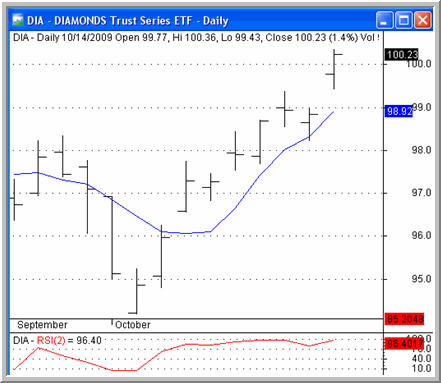ETF PowerRatings and Options Trading: Strategies for Short Term Gains
First, a comment on the current market. The ETF market has been particularly overbought over the past few days. Even before the Dow crossed the 10,000 level, we were seeing multiple days of higher highs as overbought ETF markets became even more overbought.
Right now, the only ETFs that are pulling back to any degree are bond ETFs like the ^BND^ and the ^LQD^. Most of the ETFs in the market are both overbought and trading above the 200-day moving average. When this happens, it means that it is time for high probability traders to exercise patience and discipline until the next round of set-ups occur – meaning exchange-traded funds (ETFs) with ETF PowerRatings of at least 8 and preferably 9 or 10.

As the Dow industrials passes the 10,000 mark, the ^DIA^) closes in overbought territory above the 200-day for a seventh day in a row.
For now, let’s take a quick look at another way for high probability ETF traders to take advantage of the edges in our highest PowerRating ETFs: trading options.
Most of the widely-traded equity index and country ETFs have options, calls and puts that can be traded in addition to – or instead of – the underlying exchange-traded funds. As is the case with ETFs, traders should check with their broker to make sure that the options they may be interested in are liquid. But failing that, options trading represents a worth-considering opportunity for many short term traders.
When it comes to trading options with ETF PowerRatings, there are a number of approaches. Some short term traders, looking for more bang for their buck, prefer to use out-the-money options. For example, such a trader looking to trade a high PowerRating ETF priced at $20, may choose to buy the $22.50 or even the $25 calls.
Other traders use options in a way that allows them to more accurately function as stock substitutes. This approach calls for using options that are in the money, ideally deep in the money. Using the above example, a trader interested in an ETF that closed at $20, would look to buy options – let’s say, calls for an instance of buying a pullback – that were priced at $15 or even lower.
What is the difference between the two strategies? With the first, out-the-money options strategy, the trader will be buying options that have a lower dollar price and can leverage this fact for sizable gains if the underlying ETF moves dramatically when it reverts to its mean.
The second approach, however, has its advantages. Perhaps most importantly, because they are deep in the money, options in this case will more accurately track the price of the underlying ETF compared to the out-the-money options strategy. What the trader may lose in terms of being able to buy larger numbers of lower priced options in following the first strategy, the trader gains in the second strategy by being relatively certain that his or her deep in the money option will advance in tandem with its underlying ETF.
These are just a few of the ways that short term traders using our ETF PowerRatings can take advantage of the nearly 80% correct edge that our research has uncovered in top-rated ETFs based on thousands of simulated ETF trades going back to 2003.
There are more advanced options strategies, strategies that involve selling or writing options, for example, as well as multiple-leg options strategies like spreads. We will be sure to discuss these advanced options strategies in greater detail in the weeks and months to come.
Isn’t it time you gave PowerRatings a try? Our top-rated ETFs have been correct nearly 80% of the time since 2003. Click here to launch your free, 7-day trial to our ETF PowerRatings today!
David Penn is Editor in Chief at TradingMarkets.com.
